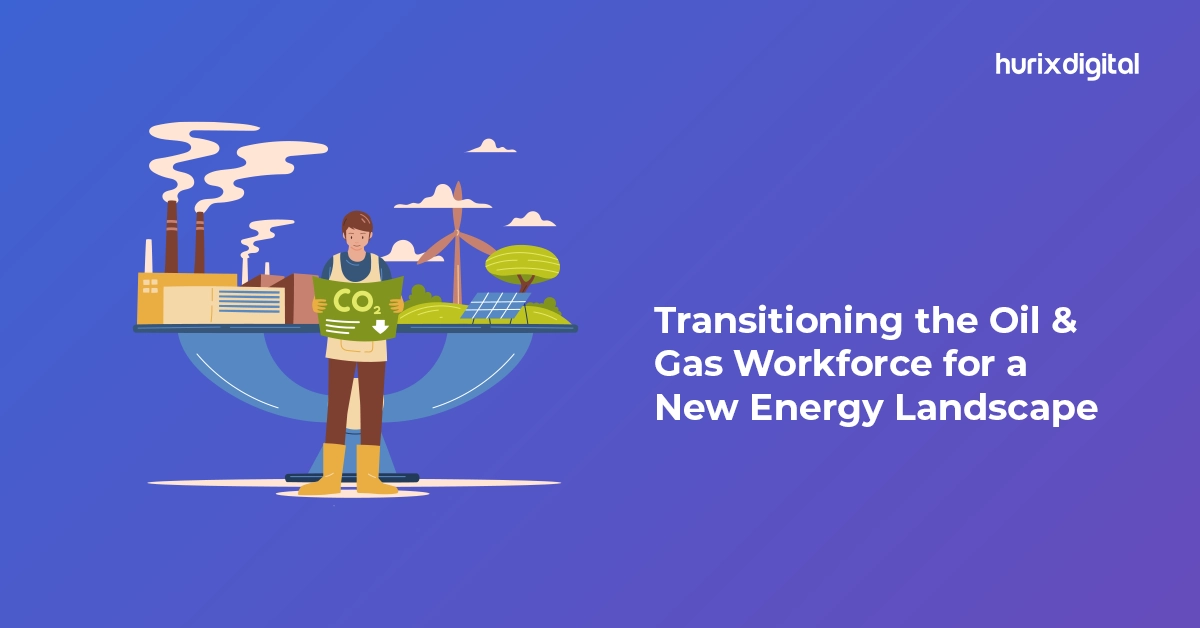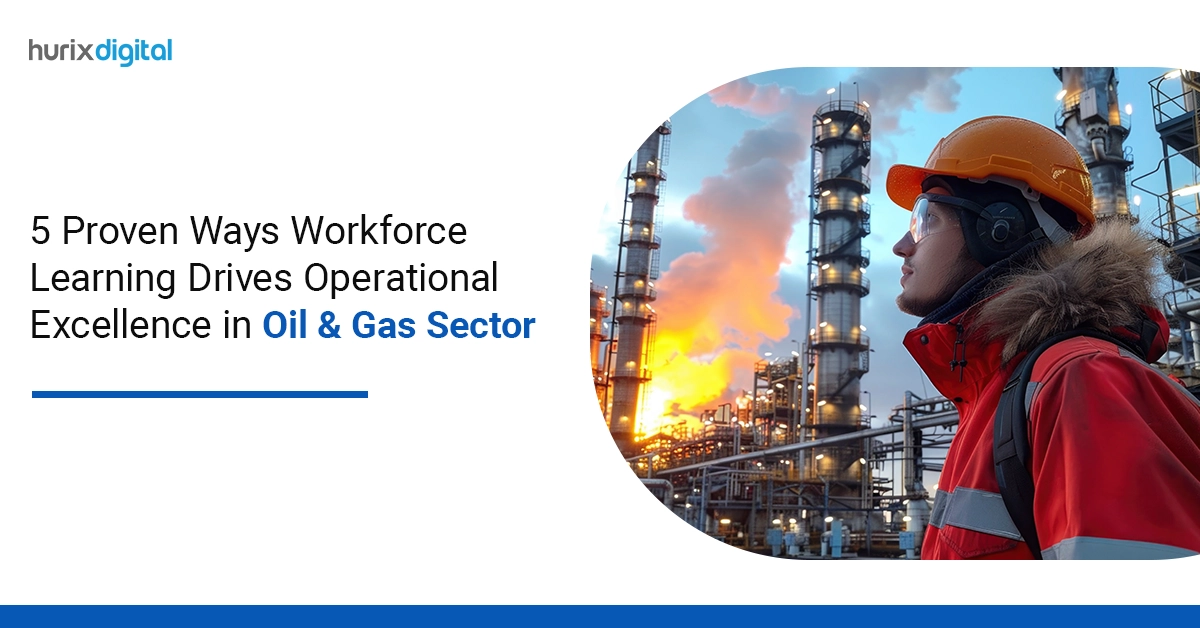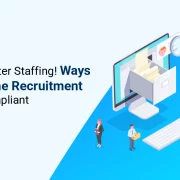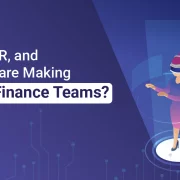
Transitioning the Oil & Gas Workforce for a New Energy Landscape
Summary
This blog post discusses transitioning the oil and gas workforce to a new energy landscape. It highlights strategies for upskilling employees, adopting new technologies, and preparing for shifts in industry demands.
The global energy landscape is undergoing a seismic shift.
Driven by concerns about sustainability, countries and businesses are adopting renewable energy sources at an increasing rate, with projections estimating that these sources will account for half of the global energy mix by 2050.
This rearrangement presents a critical challenge for the oil & gas industry, demanding a skilled and adaptable workforce primed to succeed in this evolving environment.
Workforce transformation is indispensable for oil and gas companies, given the demands of the rapidly changing energy industry and the need to close the emerging skills gap.
Read on as we explore how companies are implementing comprehensive reskilling and upskilling programs to equip their workforce with expertise in renewable energy technologies and sustainable practices.
Table of Contents:
- Understanding the Energy Transition
- The Challenge: Skills Gap and Changing Needs
- Strategies for a Future-Ready Energy Workforce
- Wrapping Up
Understanding the Energy Transition
The transition to cleaner energy extends a compelling opportunity for job creation. In a major report, the International Energy Agency (IEA) predicts over 30 million fresh jobs in the green energy sector by 2030.
The employment market for fossil fuels will contract in tandem with this increase, especially in sectors like coal supply, which are experiencing significant downsizing as a result of decarbonization and automation. Proactive workforce transformation is necessary to capitalize on opportunities elicited by a low-carbon energy future.
This workforce transformation process is already underway for businesses and employees looking to acquire a competitive edge. Fortunately, most current energy experts are well-positioned to move to cleaner energy sources.
The good news is that most energy experts now in employment are qualified to switch to cleaner energy sources.
According to a recent Robert Gordon University study, more than 90% of UK workers in the oil and gas industry have transferable skills highly applicable to positions in renewable energy. These transferable abilities, including project management, knowledge of engineering and health and safety procedures, and experience servicing and maintaining complicated systems, are all valuable assets in the renewable energy industry.
Also Read: Meeting the Needs of Changing Student Demographics and Workforce Demands
The Challenge: Skills Gap and Changing Needs
The energy transition necessitates a comprehensive reevaluation of the skillsets required within the Oil and Gas industry and workforce learning and development initiatives. While traditional expertise in areas like exploration and drilling remains valuable, it is no longer sufficient.
A new and multifaceted skills gap is emerging as the industry embraces cleaner energy sources.
To bridge this gap and ensure long-term success, oil & gas companies must prioritize the development of critical capabilities in several key areas:
1. Data Analytics and Digitalization
To maximize efficiency and forecast energy production, wind, solar, and geothermal power, for example, significantly rely on data analysis.
Conventional oil and gas workers might not be as adept at managing and interpreting data as they should be, which would limit their capacity to make meaningful contributions to the new energy environment.
In addition, the sector is rapidly changing due to digitalization. Integrating renewable energy sources into the system requires a thorough understanding of digital communication protocols and smart grid technology.
2. Sustainability Expertise
Sustainability initiatives are becoming increasingly significant in the energy sector.
Moreover, understanding carbon capture and storage technology and ways to reduce environmental effects is essential for conscientious growth in the renewable energy sector.
3. Project Management and Scalability
The workforce is critical to enabling scalability, a key determinant of success in the energy sector.
Energy firms require a staff capable of handling ever-more complicated operations as they grow both regionally and throughout various areas of the energy value chain.
It takes workers with a variety of skill sets, from data analytics to project management, to guarantee the smooth integration of new assets, efficient processes, and the upholding of quality and safety standards on a large scale.
Strategies for a Future-Ready Energy Workforce
Upskilling current employees and attracting new talent with experience in renewable energy are crucial components of the oil and gas industry’s successful workforce transformation plan.
These tactics, when applied at the corporate and sectoral levels, can enable the energy sector to develop a more inclusive, varied, and flexible workforce.
1. Within Organizations
Here’s a snapshot of how organizations can strategically prepare their workforce for the future:
- Future-Back Workforce Planning: Companies must take a proactive approach using strategic workforce planning. It involves carefully analyzing workplace transformation strategy, market demand, and current attrition trends to pinpoint the skills and talent required for the future. Businesses can utilize this data to prioritize efforts in upskilling and guarantee that they are developing a workforce capable of tackling upcoming challenges.
- Leadership for Change: Executive leadership must be firmly on board to cultivate a diverse and inclusive workforce. It necessitates a unified commitment to quantifiable DEI goals, a clear understanding of the need for change, and the establishment of measurable targets. To provide a clear grasp of the business case for change and to build an inclusive culture, effective leadership necessitates a blend of empathy and rationality.
- Upskilling and Capability Building: Successfully bridging the skills gap demands investment in workforce learning and development. Human resources, cultural leaders, and managers need sharper capabilities to identify skill gaps, promote inclusive behaviors, align systems, and nurture empathetic leadership skills.
- Building the Infrastructure for Progress: Tracking progress and encouraging accountability are crucial. Organizations should establish dedicated DEI teams and committees, implement data collection and measurement systems, and tie executive incentives to DEI goals.
2. Industry-Wide Collaboration
Here’s a glimpse of how industry-wide collaboration can further enhance the readiness of the energy workforce for the future:
- Cross-Industry Collaboration on DEI: The Workforce Energy project of the International Association of Oil & Gas Producers is a paradigm for industry-wide cooperation on DEI initiatives. Businesses that join this effort can pool their resources and expertise, exchange best practices, and work together to solve the skills shortage.
- The DEI Metrics are Standardized: Companies can benchmark their progress and pinpoint areas for improvement by establishing clear, standardized DEI criteria with minimum commitments and transparency expectations. This common framework encourages responsibility and promotes advancement within the sector.
- Sharing Best Practices: Openly sharing best practices for attracting and retaining a diverse workforce benefits the entire industry. Treating this as a collaborative effort with shared opportunities allows companies to learn from each other’s successes and accelerate progress.
- Monitoring Infrastructure for Public Accountability: For maintaining public trust and holding businesses accountable for their DEI promises, establishing a monitoring infrastructure is essential.
- Sustainability Focus: The sector’s potential to thrive in the future depends on its dedication to sustainable solutions. Prospective employees who value working for organizations with a positive impact will be impressed by a focus on environmental responsibility.
- Workforce as the Core: The success of the industry revolves around its workforce, which is considered its core. Prioritizing human-centric methods that encourage a healthy work environment and promote employee well-being is necessary to retain qualified staff.
Also Read: Adapting Workforce L&D Programs to the Virtual and Hybrid Landscapes
Wrapping Up
The energy sector is at a critical juncture today.
The industry can seize the opportunity to establish leadership in sustainable practices and future-proof its workforce by adopting sustainability as a fundamental concept and integrating those principles into its talent strategy.
A successful transformation of the energy workforce requires a collaborative effort. A workforce transformation consulting firm may help businesses navigate the energy transition by helping them create a talent pool that is prepared for the future and upskill their employees.
At Hurix Digital, we place a high priority on acquiring the abilities needed to succeed in the clean energy industry.
Our forward-thinking workforce transformation services guarantee a knowledgeable and flexible workforce ready to handle the challenges of a low-carbon future and pave the path for a more sustainable society.
Contact us now!

A highly enthusiastic and motivated sales professional with over twenty five years of experience in solution selling of training-related applications and services. Maintains an assertive and dynamic style that generates results. Ability to establish long-term relationships with clients built on trust, quality of service and strategic vision. Specializes in financial services, higher ed, publishing and government in the areas of learning and development.



